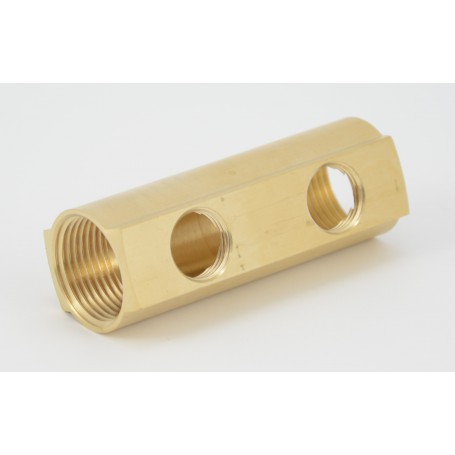Distribution beam fi 1 "x1/2" x2
- Color
- Gold
- Diameter
- 1 "x1/2" x2
- Operating pressure
- MAX 1 MPa
- Operating temperature
- MAX + 95 Degrees C
- Standard
- PN-EN ISO 21003
- Types
- Brass
Have questions? We are here for you
High quality, attractive prices.
Don't wait, we process immediately.
Offer for everyone, delivery across Europe.
PEX pipe and fittings system
We offer a wide selection of pipes and fittings for modernization and new installations from the PEX system for the transmission of hot and cold water and for the installation of central heating as well as other sanitary applications in industrial and residential construction with various dimensions and operating parameters. Multilayer pipes are produced in diameters from fi 16mm to fi 25mm with nominal pressure PN 10 in white. Made of high-strength plastic, it does not allow the formation of stone in installations, which significantly extends the service life. Pipes and fittings are resistant to long-term pressure and high temperature. Made of the highest quality materials guarantees the installation's operation for up to 50 years.
Advantages of the produced system:
- made of the highest quality plastic
- easy assembly
- high flexibility
- high and low temperature resistance
- resistance to limescale inside the pipe
- minimal heat expansion
- corrosion resistance
- lightness and ease of transport
- high chemical resistance
- plasticity even at low temperatures
- low linear expansion coefficient
- oxygen tightness and anti-diffusivity
- silent operation of the installation
PEX pipe
The pipe is made of plastic with high strength and durability, it is resistant to long-term pressure and high temperature, due to its multi-layer composition consisting of five interconnected layers. Thanks to this construction, the pipes combine the advantages of plastic with metal. The core of the aluminum layer is an anti-diffusion barrier and limits the thermal expansion of the pipe, which is connected by two layers of adhesive with layers of polypropylene, resistant to high temperatures. The pipes are characterized by m. I. High plasticity, enabling their free bending while maintaining shape stability and high compression resistance.
Properties of PEX multilayer pipes:
- maximum working temperature: 95 degrees Celsius
- maximum working pressure: 1.0MPa (10 bar)
- high thermal conductivity: 0.45 W / mK
- coefficient of linear expansion: 0.025mm / mK
- minimum bending radius: manual: 5xD (D- pipe diameter); with a spring: 2,5xD
- absolute roughness: 0.005mm - thanks to this we get low water flow resistance
Bolted PEX system
The main advantage of the PEX bolted system is that it does not require specialized and expensive tools. The system allows multiple connecting and disconnecting elements without additional seals. Installation is done by tightening the nut on the fitting and at the same time tightening the ring on the pipe. The pipes are clamped on the fitting and sealed with two EPDM O-rings. Thanks to this we obtain a tight and durable connection. The system is very resistant to torsion, bending and tearing during operation, because it has thickened walls in places most exposed to damage.
Assembly:
- Pipe cutting - the cutting plane should be perpendicular to the pipe axis. Use circular knives or cutters that guarantee a perpendicular and straight cutting plane.
- Pipe bending - the pipes can be bent in different directions, provided that a minimum of bending diameter. Particular attention should be paid so that the pipe does not flatten at the bending point.
- Calibration and chamfering - the pipe should be given a circular shape (calibrated) and sharp edges should be removed (chamfered) so as not to damage the seals.
- Fitting the pipe fitting - Slide the nut and clamping ring onto the pipe end. Then slide the pipe onto the fitting as far as it will go and slide the clamping ring with the nut towards the fitting and screw the connection by hand.
- Tightening the fitting - tighten the nut on the fitting using wrenches - one wrench is mounted on the fitting and the other on the nut. The tight connection is the result of a twisted ring that tightens under the nut. Correct assembly (screwing) of the fitting guarantees tightness throughout its entire service life.
PEX clamping system
The main advantage of the clamping system is undoubtedly very quick and simple assembly, carried out using specialized tools without the need for tightening. The fittings are made of brass alloy. The applied solutions from the clamping system ensure high durability of the fitting. The pipe is pressed against two gaskets that seal the connection with a metal sleeve. It should be remembered that when using fittings with threaded ends, it is allowed to use Teflon tape. This construction ensures correct and tight operation of the installation under the concrete layer.
- Pipe cutting - the cutting plane should be perpendicular to the pipe axis. Use circular knives or cutters that guarantee a perpendicular and straight cutting plane.
- Pipe bending - the pipes can be bent in different directions, provided that a minimum of bending diameter. Particular attention should be paid so that the pipe does not flatten at the bending point.
- Calibration and chamfering - the pipe should be given a circular shape (calibrated) and sharp edges should be removed (chamfered) so as not to damage the seals.
- Fitting the pipe fitting - Slide the pipe onto the fitting as far as it will go. The end of the pipe should be visible in the control holes located at the end of the sleeve.
- Preparation for crimping - the attached fitting should be placed in the clamping jaws in such a way that the edge of the jaws contacts the ring that is placed on the fitting.
- Clamping the connection - close the jaws and tighten the fitting until the jaws are fully tightened.
System Performance
The WiPlast company offers a system of twisted and clamp PEX pipes designed for central heating and water distribution installations according to PN-EN ISO 21003 standard, produced on the most modern technological lines. The goal of our company is to provide customers and users with the highest quality products ensuring comfort of work for installers (simplicity and speed of assembly of our system), perfect operation of the installation for end users for many years.
- Color
- Gold
- Diameter
- 1 "x1/2" x2
- Operating pressure
- MAX 1 MPa
- Operating temperature
- MAX + 95 Degrees C
- Standard
- PN-EN ISO 21003
- Types
- Brass
Montaż instalacji PEX (system skręcany i zaprasowany)
Przed rozpoczęciem prac należy dokładnie sprawdzić czy okolica połączenia rury jest prosta oraz czy nie posiada zagięć. Połączenia powinny być wykonywane na prostym odcinku rury, który musi wynosić nie mniej niż 3 x średnica zewnętrzna rury, oraz nie może podlegać żadnym naprężeniom wzdłuż osi. Gięcie końcówek wykonuje się za pomocą sprężyny wewnętrznej natomiast gięcie samej rury przy użyciu sprężyny zewnętrznej. Zaleca się aby montaż odbywał się w temperaturze dodatniej. Kształtki oraz końcówki rury powinny być czyste, bez zanieczyszczeń mechanicznych, a koniec rury powinien posiadać fazę wewnętrzną wykonaną kalibratorem. Połączenia przy użyciu kształtek skręcanych lub zaciskowych używane są przy montażu instalacji natynkowych np. z grzejnikami lub rozdzielaczami. System PEX montowany jest w instalacjach zimnej i ciepłej wody użytkowej, centralnego ogrzewania, sprężonego powietrza i nie tylko.
Obcinanie rur
Rury należy obcinać za pomocą nożyc lub obcinarki krążkowej prostopadle do osi. Zaleca się ostrożne przecinanie aby nie odkształcić jej przekroju.
Kalibrowanie i fazowanie

Po obcięciu rury należy ją skalibrować, używając do tego celu trzpienia kalibrującego odpowiedniej średnicy. Proces należy przeprowadzić jednocześnie wciskając i okręcając rurę do końca trzpienia kalibrującego. Kalibratorem powiększamy średnicę rur tak, by przygotowana końcówka podczas osadzania na kształtce nie uszkodziła oringów. Końcówkę rury należy wykalibrować tak, aby osadzenie jej w kształtce było swobodne. Następnie należy usunąć powstałe we wnętrzu rury zabrudzenia lub wiórki materiału.
Gięcie rur
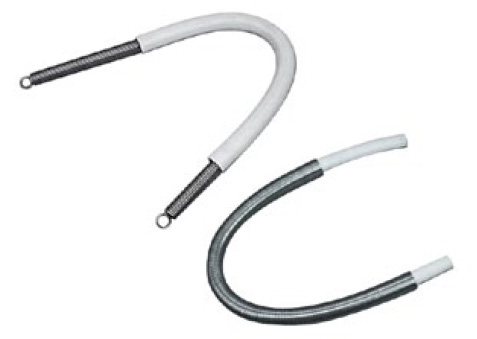
Rury wielowarstwowe można wyginać ręcznie lub za pomocą specjalnej sprężyny do gięcia rur. Stosując sprężynę unikniemy załamania i zwężenia przekroju rury. Przy wyginaniu należy pamiętać aby zachować minimalny promień gięcia.
Montaż kształtek skręcanych
1. Na obcięty koniec rury należy wsunąć nakrętkę i zaraz pierścień zaciskowy.![]()
2. Na tak przygotowaną rurę wsuwamy kształtkę i rurę dociskamy do oporu do dna kształtki.
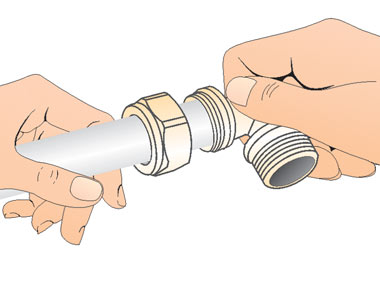
3. Następnie dociskamy pierścień, korpus kształtki przytrzymujemy kluczem płaskim, a drugim dokręcamy nakrętkę, tak aby końce pierścienia zetknęły się ze sobą.
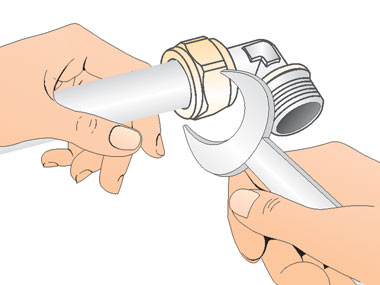
4.Dokładne dokręcenie nakrętki powoduje zaciśnięcie pierścienia i uszczelnienie połączenia.
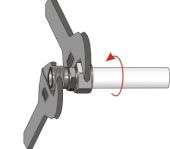
Montaż kształtek zaprasowanych
1. Rurę należy wsunąć w złączkę, aż do pojawienia się jej w otworze pierścienia wykonanego z tworzywa sztucznego.
Pojawienie się rury w otworze kontrolnym świadczy o wsunięciu się jej w złączkę na wymagana głębokość.

2. Zacisk złącza wykonuje się za pomocą specjalnych narzędzi zaciskowych (ręcznych lub elektrycznych) oraz za pomocą szczęki tytu „U”. W celu wykonania prawidłowego połączenia szczęki powinny przylegać do pierścienia zatrzaskowego z PE.
Zaciskamy połączenie. Proces zaciskania przeprowadza się aż do momentu, gdy szczęki zaciskowe zamkną się całkowicie – jest to warunek uzyskania prawidłowego połączenia.

3. Sprawdzenie zaciśniętego połączenia - po zaciśnięciu kształtki na rurze PEX wielowarstwowej, należy sprawdzić jakość połączenia narzędziem (Sprawdzian do połączeń zaciskanych 14-32mm)
pozwala to na określenie czy kształtka została zaciśnięta z odpowiednią siłą.
Oraz sprawdzić ponownie otwory kontrolne umieszczone na końcachtuleji.

Wskazówki
- montaż instalacji powinien odbywać się w dodatniej temperaturze
- przewody montowane w ścianach oraz podłodze powinny być rozkładane w rurach osłonowych lub otulinach termoizolacyjnych, unikniemy wtedy bezpośredniego kontaktu złączek z agresywnymi materiałami budowlanymi, które mogły by trwale uszkodzić instalacje
- przy montażu instalacji na zewnątrz jak i wewnątrz w izolacjach należy pamiętać o kompensacji rozszerzalności termicznej rur
- nie należy betonować instalacji skręcanej w stropach ponieważ traktowane są one jako połączenia wymienne – rozłączne).
- W instalacji zaciskowej można betonować połączenia ponieważ są one nierozłączne
- Próbę szczelności należy wykonać przed pracami murarskimi
Every product showcased in our online catalog comes with a standard warranty, attesting to its quality and reliability. We strive to ensure that every offer in the water and sewage sector stands as a testament to our commitment to reliability and trust for our customers.
We recognize that different projects might require specific warranty solutions. Thus, in response to individual needs, we offer the possibility to customize warranty terms. Should you wish to discuss the details of an individual warranty, we encourage you to contact us directly.
Our top priority is to give you the confidence that by choosing products from our catalog, you are opting for tried-and-true, durable solutions.
Fluctuations in raw material prices directly influence costs in the water and sewage industry. For this reason, all our quotes are made individually to reflect the current market situation.
We strive to offer our customers competitive prices while maintaining high product quality. Thanks to our individual approach to each inquiry, we provide attractive discounts and optimal purchasing conditions.
If you are interested in our offer, please contact us. We will happily prepare a quote for you, considering favorable conditions. Our flexibility ensures satisfaction with every purchase.

